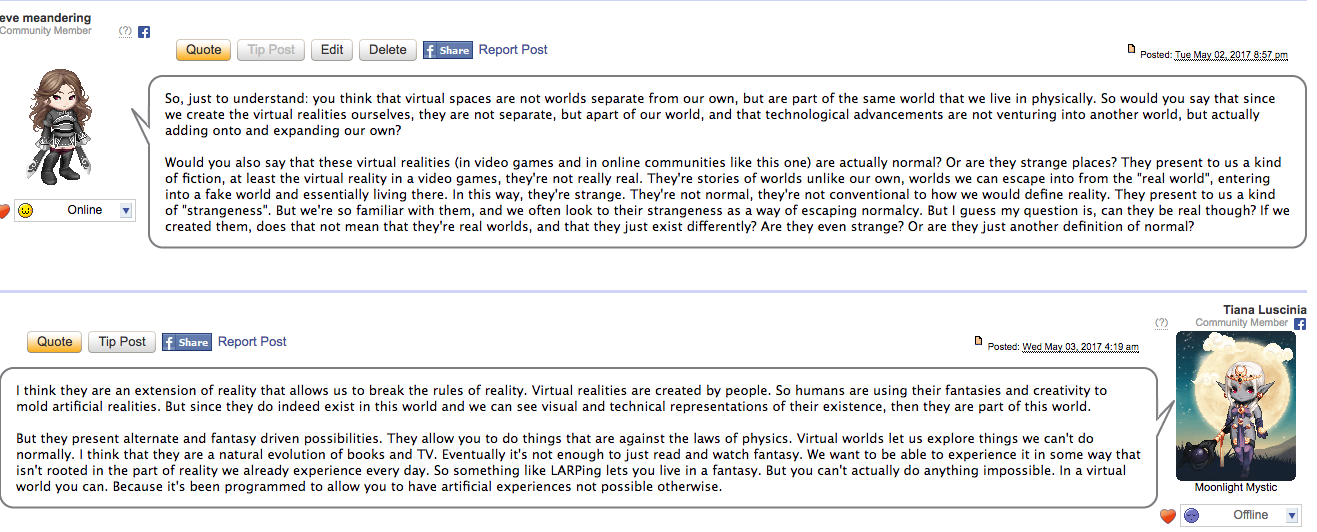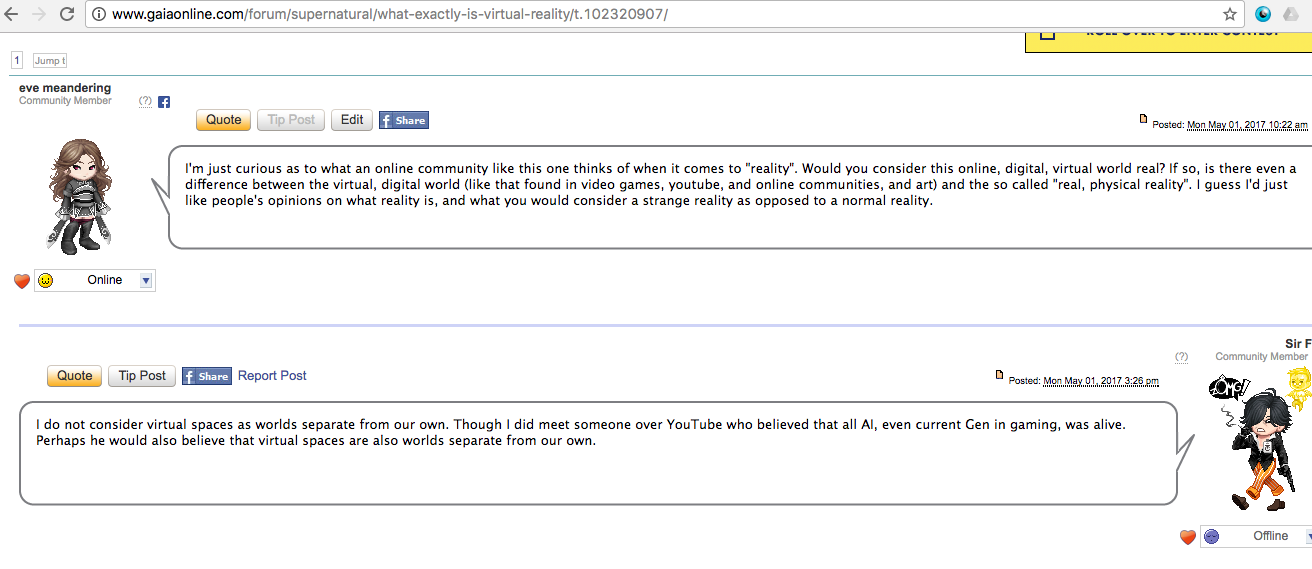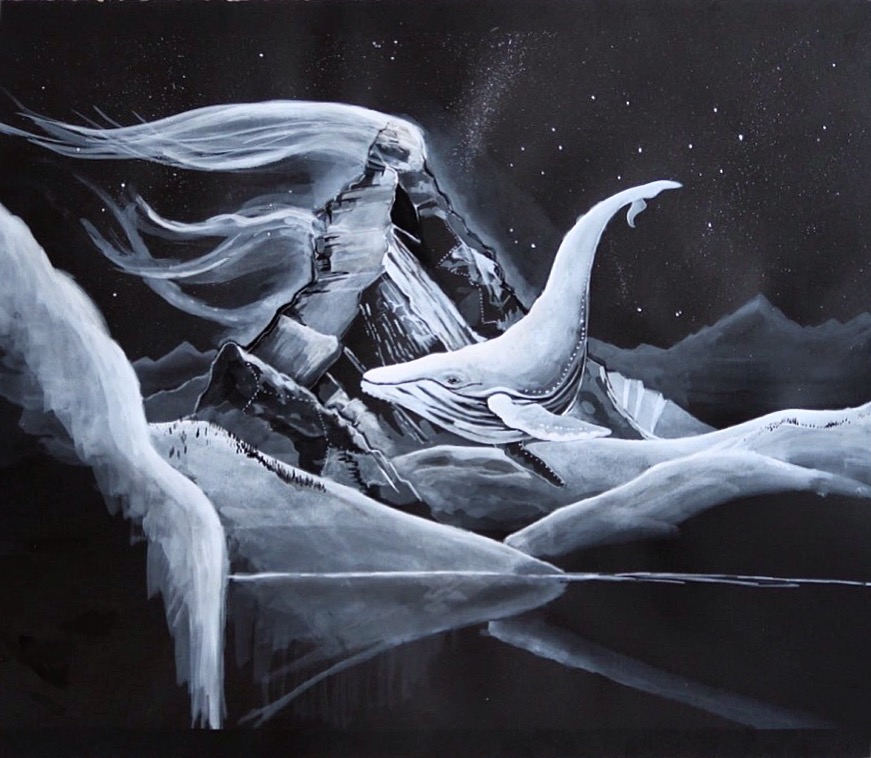


Pretty self-explanatory. But we have an hour long, visual and audio recorded conversation with Jason Chu, two typed out interviews with questions and answers from two friends, Scott Findlay and Gavin Wilkes, some conversations with people from Gaia Online, and a conversation with Marissa Bouchard.



An Interview with Scott Findlay, a community member and friend.
S: Hope this serves the purpose.
Disclaimer: I know nothing. And some of my opinions about some of these topics may have been formed as I was typing. Hope it makes some sense.
L: What are your thoughts on the virtual/alternate reality that can be found within a video game, or the gaming world itself?
Video games can be fun and relaxing (obviously :p) but also dangerous. What happens in a video game isn’t “real life”. Video games can give a sense of accomplishment by unlocking things and gaining levels or experience. It is false though. That’s not real life.
I may have bias though. I should probably give my background so you know where I’m coming from. I got a little addicted to the Call of Duty games when I was younger (age 13-17ish). It did not feel healthy. I’ll leave it at that.
– Is it healthy to be constantly fluctuating between this world and a digital one?
No. Depending on the scale or intensity of the game, I think its possible people could get them mixed up. Or want to spend more/ all of their time in the video game reality and not the “real reality”. And that’s not healthy.
– Is the reality that can be found in a video game any different from the real world we live in?
Currently, yes. That reality is made up by developers. They take your input from your controls, and give a set output through an algorithm. The output will always be the same if you give the same input. Artificial intelligence is only so intelligent at this point in time. The reality within a video game was created from this reality and is finite.
– Speaking of the “real world”, what makes this world we live in physically, “the real reality”?
Not entirely sure what this is even asking. But I’ll give it a shot anyway.
Videogames still happen in this reality. People in this reality can perceive the “fake realities” of videogames. But the videogames can’t perceive at all. Most people think they themselves perceive what others perceive (albeit from a different perceptive and interpreted differently) but essentially that they perceive the same thing as others. Only one thing happened and they both perceived that thing the one way it happened.
Hope that at least touches on the question posed.
and what makes us think that video games present us with “fake” realities?
Maybe cause when you strip a video game down, it’s just code written in the “real reality” from people who exist only in the “real reality”.
Are the physical and the digital worlds two distinct, separate realities or realms, or are they more similar than we think?
Interesting question. Video games realities exist within the game and the game exists within the “real reality”. Therefore the video game reality is just another part of the real reality? So not distinct realities. Just one with a bunch of sub-realities created from and within the real reality.
Do they intertwine, or overlap? Are the lines demarcating “our reality” and the virtual, digital, alternative reality of the video game, lines that are actually quite porous, lines that allow for crossing over?
I kind of say what I think about this above but maybe I can reiterate in another way.
These “fake realities” are not separate or different from the “real reality” because they were created solely from the “real reality”. They cannot intertwine or overlap because they’re not separate. Usually videogames do not interact with the “real reality” besides from their input. However, some might be getting there. And they’re always getting updates/ taking more input from the “real reality”.
– Or are the worlds or realities of the physical world and the digital world, in fact one in the same reality (just a reality with multiple facets and characteristics)
Yaaaaaa. That’s what I was saying.
Is there such thing as a single, capital “R” Reality?
I think so. Least I’d like to believe so. Make things complicated if there wasn’t.
What exactly does the word reality mean?
Now there’s a real humdinger.
What does reality entail for it to be considered real?
Pass
What is it about the physical world that makes it real?
42
Is the concept of a reality or multiple realities merely a human made construct, abstraction, or is reality a physical, tangible thing?
Reality is.
Certainly video games are changing our definitions of what reality is.
Not at the moment. Maybe when they’re more intricate.
– Is there just one reality, or are there multiple realities, infinite alternate realities that we aren’t even aware of….
There could be. That is beyond me.
– Are the alternate/virtual realties found in the gaming industry even possible, even real?
No. Not to the degree of the “real reality”.
Can you live in them or live through them, or are they mere appearance, illusion, lies and falsehood?
I imagine someday, you’ll be able to live your life through a videgame (Ready Player 1 – Ernest Cline) good book. But unless that “fake reality” is getting more input from the “real reality”, then the player basically has a finite coded world to “live” in. A big factor is how many players are there? We could put the whole world in one videogame (just like the book ready player 1). Did we move reality? Or is it just a really popular sub-reality?
This is actually kind of a big topic. You could pretend that a phone call is a videogame. There are two players. The input is the voices. The programming is the voices. Is one living it a sub reality? Too much to think about? Essay question in itself right there.
Do they, even though digital, present some realness, some truth?
They’re like a calculator; you only get out what you put in. Unless the AI can take two truths and make a third, then you’ll get all the truth you would from playing by reading the code of the videogame.
– What if the reality we live in right here is the virtual one, and the reality presented in the video game is actually the “real world” (GASP)
Hahaha I said earlier that the videogame can’t perceive at all. And that was the difference between a “fake reality” and the “real reality”. We can perceive though.
– What are your thoughts on Oculus Rift? Is it dangerous, does OR’s future look promising or potentially threatening?
I don’t think it changes things too much. It’s just a more lifelike interface. It’s probably still pretty primitive to what the videogame station will be like. The one that will suck humanity in.
– Where do you see the future of video games and technology in general going? Is it intimidating, or exciting to think that we are creating new worlds of possibilities (video games can be considered an art form)
I think it has a long ways to go. But something like what happens in ready player 1 seems possible. We could move our interactions with each other into a videogame setting. Maybe even for safety purposes.
– Are they truly new worlds of possibilities, if a video game is just a network of coding and numbers that all fit together like a puzzle piece? Is that all that reality is? A series of codes?
It’s all in AI. If AI technology goes far, maybe videogame realities will go far. But if it’s just straight input/output, then it’s not really a reality at all.
– Will technological advancements change the very definition of reality as we know it?
Doubt it.
Will technological advancements change our world in general?
Absolutely.
For good, or for bad? Or for a little bit of both?
Definitely both. We’ve seen it in history. Technological advancements bring both good and bad.
Why do you think video games actually exist?
Cause we made them.
Why as humans do we yearn for other worlds and other realities different from the familiar one we know and live in?
Boredom.
– Would you consider video games an art form, a type of art?
Sure
– How Is it that the concept of “strangeness” in video games (strangeness as in going to unfamiliar worlds and being presented with things that we haven’t already been acquainted with) is one we are more familiar with or comfortable with rather than our own reality we live in?
Not exactly sure what this is getting at but that’s not how it is for me. Especially a new videogame. But maybe I’m no longer qualified to answer this question as I don’t play videogames anymore.
– What is your definition of “strange” and “familiar”?
A thing that one does not know or recognized in any way?
– Video games can be seen as subverting established definitions of notions of strangeness and familiarity, taking our already preconceived notions of what they are, and flipping them on their head. If we encounter something strange, something unthinkable, something absurd or out of the ordinary in the midst of the digital world, how will it affect the strange things that can be found in the physical world, how will it change (or will it) are own definitions of what we consider to be strange?
It will dull our perception of the strange. But television/movies/news does that enough as is. I don’t know if it’s changing the definition of notions of strangeness of familiarity but I do not think it is changing the definition of strangeness or familiarity. Yet.
A really lovely and deeply contemplative conversation with Jason Chu.
Here are a few “digital reproductions” or photographs taken from my iPhone of his artwork to prelude the recorded conversation.




To stand before the art and bask in its presence, is something else altogether, let me tell you. This reproduction of Jason’s art really doesn’t do it any justice. On a digital platform, it’s now a representation of a representation. Maybe it’s an inadequacy of my phone’s camera that cannot capture the minute detail, or perhaps it is the transference into the digital, where the original artwork’s detail is generalized into pixels, and therefore lost. But without crappy cameras or pixellated images, we wouldn’t be here, would we? There are pros and cons and compromise in everything.
But if you ever are allowed the opportunity to view Jason’s work — or anyone’s for that matter — and if you are able to stand inches away from the surface, see the brushstrokes, each individual line, smudge, or dot of paint, charcoal, or chalk, it really is an honour. Because to see at least a certain extent of the process of the art, is to see a little more into the artist – and that is such an unique experience.
It’s one thing to see and know an artist, but to view the artist through their art, is to see and know them differently, maybe even strangely. Possibly to see and know them more so.
Hopefully, these pictures of these pictures give you at least a small sense of the degree to which Jason views his world: one that is both normal and strange. He subtly yet poetically erases the line between conventional standards/definitions of strange and normal, bringing these two ostensibly binary opposite categories closer. His art comments on the fluidity of our definitions surrounding concepts such as normalcy and otherness, actually inviting us to consider that a thing doesn’t have to fit nicely into either category, but can in fact be BOTH strange AND normal, instead of either or, and instead of clear cut.
The lines created by the brush or the pencil or the charcoal are lines that are not definitive, but porous. This technique replicates in art form, the notion that categories do not have to have definitive lines, but that lines separating categories and definitions are quite permeable.
The most normal things in our world can appear to be the most strange, and the most strangest things in our world, are actually the most normal. Perhaps these two opposite categories are not two distinct and opposite things, but one in the same thing.
We had the privilege to both talk with Jason and view his art. But in a way, the two are no different from one another, but one in the same thing.
Thanks so much Jason!
This is Marissa Bouchard’s, a student at Augustana with a psychology major and an art minor, very first film. It is called “A Visit”
It is hand made using a whole myriad of techniques on 16 mm found footage.
Bouchard, Marissa. A Visit: A Short Film. November 2016. Owned by Marissa Bouchard, Augustana. Video via Vimeo. Web. April 2017.
Interview with Marissa Bouchard:
L: So what exactly would you say if someone asked you what this short film is about?
M: The sequence is of a blob that naturally exists in a particular space, but has to unexpectedly leave that space to visit different and other spaces. It finds peace in these different spaces, and chooses to stay. That’s one way of looking at it. As you may notice, the blob gradually accumulates these spots on its… blob body. So there’s a possibility that the blob wasn’t voluntarily staying in these new and different spaces, but had to due to a sickness or some sort of infection that was a result of staying in these new spaces. The blob becomes decrepit, and in the end, you see a space, which is a sunset, but the blob is no longer there. It’s open ended. It could be that the blob decided to stay, and become one with space… it evolved from a blob into an entity that would fit in, that its blob-ness had to disintegrate so that it could stay in the new found spaces it found itself in. Another possibility is that the blob could have died. It either stayed or as a result of its staying, had to die.
It’s really about a visit to a place and either the result of this visit, or the consequences of the visit.
It’s really just a visit though, so it can be open to any interpretation. And I just made it, right? It’s not my job to attach definitive meaning onto it. It’s meant to be open-ended so that the viewer can bring their own meaning and perspective to the art, and draw the art’s meaning from their own… meaning.
L: “I like that loose definition of art. I really enjoy how the ending is up to one’s interpretation of it”
M: “Yeah, it has to be loose. Nothing is definitive, or so precise as a definition.”
L: “I also loved how there are no voices or music. It’s just silent, and I think that really harkens to and emphasizes the ambiguity, the lack of clear meaning.
M: “Yeah, I really considered putting in music or spoken word or just any noise really. Maybe voices or some dissonant background stuff. But towards the end, I realized what the film had come to be and mean for me. It’s just a visit and nothing more. That way it can be more open ended, more liberating for any viewer, and possibly more frustrating… kind of like life itself. There are so many options, and possibilities, and no one really knows what they’re doing, no one can foresee the potential ramifications of their actions. It’s very much like life itself.